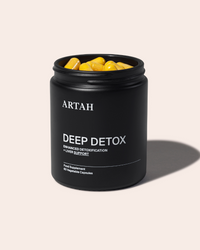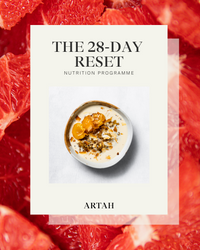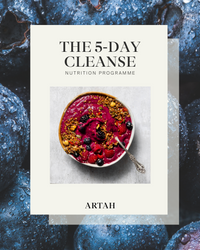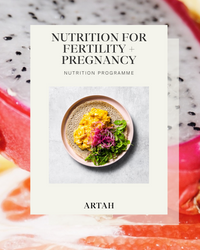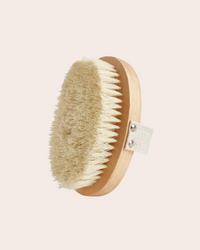Here's What You Need To Know About Perimenopause
Perimenopause is simply the time before menopause, and refers to the physiological changes and hormone decline that happen naturally as we age.
Each individual will enter perimenopause at a different time, and whilst the general age range is from 40-44, it can start as early as 35. Although the drop in hormone levels can be gradual at first, it can still have a profound effect on our health and wellbeing, and often causes significant confusion and frustration among women who struggle to understand what is going on with their bodies. Understanding our biochemical landscape throughout this time can be hugely empowering, because the way we take care of ourselves throughout perimenopause is not only essential for our day-to-day energy, but it also directly influences how we experience menopause. Here's what we think you should know.
WHAT IS HAPPENING IN PERIMENOPAUSE?
As we breeze through our late thirties, the levels and consistency of oestrogen, testosterone, and progesterone start to become irregular. Our bodies are preparing to stop the process of ovulation, which means our ovarian function is on the decline. For some women, it may start as early as their mid-thirties, and for others it will be later, but the term 'perimenopause' encompasses the myriad of changes that occur in the 15 years leading up to menopause. So, although the onset will differ for everyone, it’s something to be aware of far earlier than you may have thought.
Before we go on, if you’re reading this in your thirties and are still looking to get pregnant don’t fret – you can absolutely still get pregnant throughout these years. But what it does mean (whether a baby is your end goal or not), is that we need to ensure we’re taking care of our hormone health, not only to reduce symptoms of perimenopause, but to set ourselves up for a smoother transition through menopause.
SEX HORMONES
One of the first changes that occurs is a gradual decline in progesterone, our pro-gestation hormone. When we're cyclical, progesterone is responsible for building the endometrial lining to prepare for pregnancy, it helps control menstrual bleeding, and is important for the regulation of our mood. As progesterone drops, it can results in anxiety, poor sleep, increased breast tenderness, water retention, heavier bleeds and eventually, shorter cycles.
Estrogen production also drops, however, this can often be more erratic than the slower, more gradual reduction in progesterone. As estrogen fluctuates, other symptoms can start to occur, such as a drop in libido, hot flashes, a change in sleep patterns, and vaginal dryness.
In addition to fluctuating sex hormones, there will also be changes in cortisol, thyroid hormones, insulin, leptin, and eventually, a sharp drop in oestrogen that hits while we’re in full blown menopause. This is when our ovaries don't produce enough sex hormone to trigger ovulation and release eggs, and we can no longer fall pregnant.
THE EFFECT OF STRESS
As our ovaries start to back off on the production of oestrogen, progesterone, and testosterone, our adrenal glands step up. They take on the role of making these essential hormones once our ovaries step down, and whilst the amount produced is low, it's still important, which is why adrenal stress is an important lever to managing your symptoms. Enter: chronic stress, and its effect on adrenal capacity. This is often the time in a woman’s life where stress is at its highest – whether it be from work, family or trying to juggle them both, the effects of stress are definitely more apparent as we approach this transition. If our adrenals are already overburdened, the production of stress hormones will trump the production of sex hormones, which can worsen symptoms. This will also have a strong influence on our mood. Chronically elevated cortisol can depress serotonin and dopamine, and because a loss of oestrogen will also decrease serotonin levels, managing stress is an essential part of combatting anxiety, depression, and low mood during this time.
METABOLIC CHANGES
Although metabolic changes happen a little later in the process, women in their thirties will definitely feel the shift (it’s suddenly a little harder to get away with staying up all night and eating poorly). As we age, we all - men included- start to lose our sensitivity to insulin, but this is more pronounced in women because of its relationship to oestrogen. As oestrogen declines, so will our insulin sensitivity. The best way to combat this is of course, ensuring our diet is low in sugar, refined carbohydrates and excess starch. But another key contributor is the amount of lean muscle mass we have. Maintaining good lean muscle mass helps us stay more metabolically fit by improving our glucose uptake and insulin sensitivity. Simply put: resistance training should be a definite fixture in your thirties and beyond.
Another change that happens for both sexes is a decline in testosterone. Although this is generally age related, it is happening at the same time as our perimenopausal swings are in full effect, so will contribute to our sex drive and also indirectly, our insulin sensitivity. Weight training is a stimulus for testosterone production, making resistance training even more important during this phase.
This transition can sound daunting, but it's a good time to tune in to how we're feeling and give ourselves permission to lean into a more supportive and intuitive way of living. It's the perfect time to set boundaries and really focus on our wellbeing. If our baseline is healthy and strong throughout this phase, it can help ease the transition to menopause and reduce the severity of symptoms, and tweaks in our lifestyle including nutrition, stress management, supplementation and fitness, can help make all the difference.
SUPPORTING YOUR HORMONES
In your 30’s…
— Make stress management a priority so that you’ve cemented good habits as life gets more complicated.
— Start to prioritise resistance training. Building muscle is easier when we’re younger and will help us stay more resilient to the metabolic changes that are coming. It doesn’t mean you need to stop cardio, but make strength work a regular part of your regime now to reap the full benefits.
— Take probiotics to keep your gut on track. The estrobolome is the part of your gut that helps metabolise oestrogens, and its role in women’s health is becoming more apparent every year. If you’re suffering from IBS in your thirties, it’s something to get a firm handle on before you hit forty to increase your chance of hormonal harmony.
— Support yourself with adaptogens. Ashwaganda can help maintain healthy cortisol levels and is our go to adaptogen for all things stress related. Enhanced Nootropics comes with the added benefits of magnesium and methylated b vitamins, which are essential for health hormones, mood, and sleep, so is our supplement of choice.
— Be mindful of how alcohol affects you at different stages of your menstrual cycle. You'll find that it's gets harder to handle alcohol in the latter two weeks of your cycle, so modifying how much you drink and when can help optimise your biology to decrease fluctuations in mood, energy, and cortisol.
In your 40’s…
— Stress management continues to take main stage as your hormones shift to the later stages of perimenopause. Remember, you want your adrenals to feel happy and healthy by the time they need to take on sex hormone production.
— Strength training should be a primary focus and with that, we can often see a need for more protein intake. This doesn’t mean you need to increase meat but ensuring your protein intake is solid will help ensure you’re building and maintaining the muscle you need to fuel your metabolism.
— Increase phytoestrogens from food, which have been shown to reduce hot flashes and improve symptoms of menopause. These include organic soy (fermented is best), chickpeas, lentils and peas.
— It’s fair to say that one of the things women fear about the menopausal years is weight gain. But it’s not a given, and the more you can support your insulin levels the better. The first line of defence is the diet, so keep the sweet stuff low (you know the drill).
— The second line of defence is supporting your metabolic and hormone health with our Perimenopause Set. This set combines targeted vitamins, fatty acids and adaptogens for stress, hormones and metabolism.
Regardless of age…
— A worsening of PMS can be a sign of changing hormone levels. GLA has been shown to decrease symptoms of both PMS, perimenopause, and menopause, so if you’re suffering from breast tenderness, tearfulness, water retention and painful periods, Essential GLA can be a life saver in the luteal phase. Once you’re closer to menopause, taking it all month long can help combat hot flashes and some of the other symptoms including insomnia, mood swings and anxiety.
This article is for educational purposes only and the implementation of the theories and practices discussed is at the sole discretion of the individual. All advice given is not a substitute for medical advice, diagnosis, or treatment. If you have any concerns about your health, you should speak with your physician.














